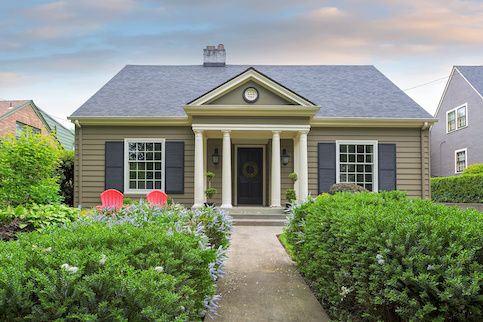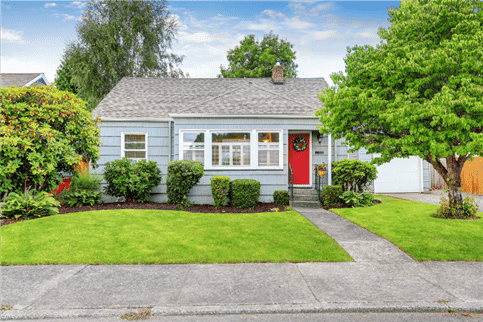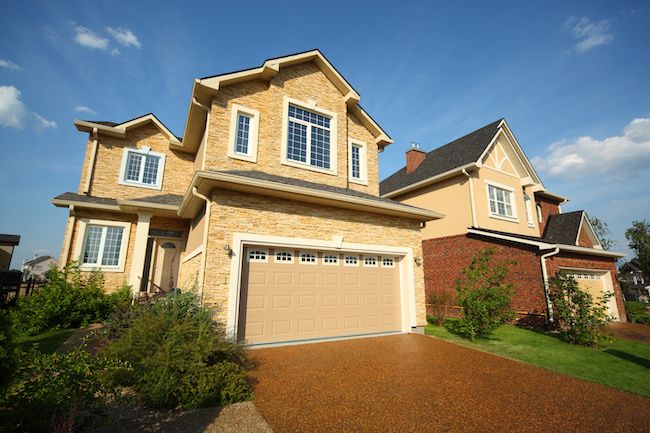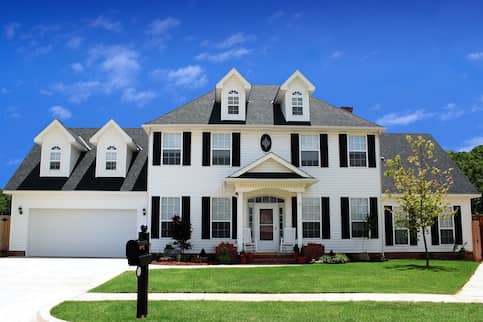Fixed-Rate Vs. Variable-Rate Loans

No borrower ever sets out to pay their lender as much money as possible. Instead, whether they’re looking for a mortgage or a personal loan, they’re likely on the hunt for a bargain. If you are on the journey to become a homeowner or are looking for a debt consolidation loan, interest is a crucial factor (and a number you want to be as low as possible).
You might notice the options of fixed-rate vs. variable-rate loans when shopping around for a loan. In the mortgage world, variable-rate loans are called adjustable-rate mortgages, while fixed-rate mortgages are another choice. Here’s a breakdown of the differences between the two and how the nuances play out for mortgages and other loan types.
What Is A Fixed-Rate Loan Vs. A Variable-Rate Loan?
Distinguishing between a fixed-rate loan and a variable-rate loan means understanding how their interest rates behave over time and affect your monthly payments. With a fixed-rate loan, the interest rate remains constant throughout the life of the loan. This consistency in the interest rate translates to stable monthly principal and interest payments that don’t rise or fall over time. Borrowers benefit from protection against market fluctuations because they lock in their interest rate when they first get the mortgage.
On the other hand, variable-rate loans introduce an element of uncertainty because their interest rates fluctuate periodically. These changes usually correlate to financial indices such as the U.S. Prime Rate or the Secured Overnight Financing Rate (SOFR). They can also change according to a rate stated in the loan terms.
This feature means your monthly payments could spike if the interest rate increases, presenting more risk to borrowers. Variable-rate loans typically mitigate this risk with interest rate caps, which limit the interest rate growth. That being said, the extent and frequency of these adjustments depend on the terms outlined in the loan agreement, so it’s important to understand the terms before signing. For example, credit cards can go from a 0% introductory APR to 25% APR, creating a drastic swing in debt accrual and monthly payment amounts.
Types Of Fixed-Rate Loans
Fixed-rate loans have consistent interest rates and can serve a lot of purposes. Here are some of the types of fixed-rate loans:
- Fixed-rate mortgages are popular loans to finance the purchase of a home. The most common terms are 15, 20 or 30 years, with shorter terms bringing lower rates. Additionally, the interest rate is locked in at the beginning of the loan, providing borrowers with more predictable monthly payments over the life of the mortgage.
- Home equity loans allow homeowners to borrow against the equity in their homes for various purposes, such as home improvements, debt consolidation or major expenses. This loan type becomes a second mortgage, meaning it uses the home as collateral. Terms can vary, typically ranging from 5 – 30 years. Like fixed-rate mortgages, home equity loans offer a fixed interest rate, ensuring consistent monthly payments.
- Personal loans are unsecured loans borrowers can use for any purpose. Because they don’t require collateral, they often have higher interest rates than mortgage loans. On the plus side, the borrower doesn’t risk their property when they take out the loan. Terms typically range from 1 – 7 years, and the interest rate doesn’t change.
- Auto loans finance a vehicle purchase (usually with terms of 3 – 7 years). Because they use the purchased vehicle as collateral, they have lower interest rates than personal loans. In addition, the interest rate doesn’t change, offering steady monthly payments.
Types Of Variable-Rate Loans
Variable-rate loans usually offer an initial rate that doesn’t change for 6 months or a year. After this period expires, the rate changes. Here are a few different variable-rate loan types:
- A home equity line of credit (HELOC) turns your home equity into a financial resource you can borrow against for several years. You’ll pay interest during the time when you can borrow (known as the draw period) and then repay the loan via monthly installments. The draw period usually lasts 10 years. The interest rates on HELOCs are typically variable, meaning they’ll fluctuate based on changes in a specified financial index. Like a home equity loan, HELOCs use your home to secure the debt.
- Credit cards are accounts that provide a revolving line of credit for making everyday purchases. If you pay your account balance on time every month, you won’t owe any interest. However, carrying a balance means incurring interest charges that fluctuate with the economy. Credit cards are generally unsecured, meaning they’re not backed by collateral. As a result, they have higher interest rates than other forms of debt.
Types Of Hybrid Loans
There are also loan types that combine variable- and fixed-rate interest. They start with a fixed rate and switch to variable after a certain period of time. Here are a couple of them:
- Adjustable-rate mortgages start with a low, fixed rate and then switch to a variable rate. Adjustable-rate loans often offer lower initial interest rates, providing more affordable initial monthly payments. Then, the promotional period ends after a specified period. Once the promotional rate expires, it adjusts according to its financial index. So, if interest rates across the economy rise in the months or years following when you first opened your variable-rate loan, the interest rate (and your monthly payment) will increase.
- Credit cards with an introductory period offer borrowers a promotional 0% interest rate. This period usually lasts between 6 and 21 months, giving you ample time to carry a balance without accruing interest charges. Once the promotional rate expires, the rate adjusts to standard credit card rates.
Fixed-Rate Vs. Variable-Rate Vs. Adjustable-Rate Loans
Here’s a brief rundown of the differences between fixed-, variable- and adjustable-rate loans.
Fixed-Rate Loan | Variable-Rate Loan | Adjustable-Rate Loan | |
|---|---|---|---|
Monthly Payment/Interest Rate | Stays the same for the life of the loan. | Varies based on interest rates. | Fixed for the introductory period, adjusts regularly based on interest rates after that. |
Amount Paid Toward Principal | Increases over the life of the loan. | Varies based on interest rates. | Increases over the life of the loan. |
Amount Paid Toward Interest | Decreases over the life of the loan. | Varies based on interest rates. | Adjusts regularly based on interest rates. |
See What You Qualify For
Home Purchase
Home Refinance
Tap Into Equity
What Are The Pros And Cons Of Fixed-Rate Loans?
The unchanging payments with fixed-rate loans can be a double-edged sword. Here’s a breakdown of the pros and cons:
Fixed-Rate Loan Pros
- Easier to budget: Fixed-rate loans have a monthly principal and interest payment that never changes over the life of the loan. Borrowers can make a more reliable, realistic budget thanks to the predictability.
- Keep pace with depreciation: Fixed-rate loans have modest, stable rates, meaning the interest won’t balloon on cars and other depreciating assets. This way, the rate of depreciation doesn’t outpace the total you pay for the loan.
Fixed-Rate Loan Cons
- Higher costs when rates are high: Fixed-rate loans use current economic trends to lock in an interest rate when the borrower qualifies for the loan. If interest rates fall in the future, borrowers can’t take advantage of the cheaper rates unless they refinance. Doing so involves qualifying for a refinance loan and paying origination fees.
- Less flexibility than revolving credit: While fixed-rate loan payments don’t change from month to month, they are usually paid to the borrower through a one-time lump sum. On the other hand, revolving lines of credit allow borrowers to draw funds over time as needed.
What Are The Pros And Cons Of Variable-Rate Loans?
Variable-rate loans have potential pitfalls as well as advantages for borrowers:
Variable-Rate Loan Pros
- Lower introductory rate: The lower introductory rates unique to variable-rate loans can lower your monthly payments while the rate lasts. This feature can help you afford a larger loan and avoid paying more interest.
- Greater flexibility: Variable rates can grow or shrink at each adjustment period. If the interest rate drops, you can continue making the same payment as before – only now, more of your payment goes toward the principal.
Variable-Rate Loan Cons
- Greater volatility: Variable-rate loans can change unpredictably, making budgeting for your monthly payment challenging. Plus, sudden increases in interest rates can make a loan unaffordable.
- Potential to be underwater on loans: If the interest on a loan for a home or car increases, less of your payment goes toward the principal every month. Higher loan balances and steeper interest rates can make the loan exceed the value of your property. As a result, a borrower can end up owing more than the property is worth (known as having an underwater loan). This situation makes selling your house nearly impossible because the purchase price won’t cover your mortgage.
Get matched with a lender that will work for your financial situation.
Are Variable-Rate Mortgages Available?
Although variable-rate mortgages are available, most mortgages are fixed-rate loans. Borrowers usually trade interest savings for the first several years of the loan for the consistency and predictability of a locked-in fixed rate. In other words, borrowers typically opt for less volatility when faced with fixed-rate vs. variable-rate loans.
Additionally, while variable-rate mortgages are available in other countries, the most common type of variable-rate mortgage in the United States is the adjustable-rate mortgage (ARM). ARMs provide an introductory interest rate for 7 – 10 years. After this period, the interest rate adjusts periodically. For example, a 10/1 ARM gives a low interest rate for 10 years. Then, it adjusts once per year (as signified by the “1”) for the rest of the loan.
ARMs adjust based on financial indices such as the Secured Overnight Financing Rate (SOFR), 11th District Cost of Funds Index (COFI) and constant maturity Treasury index. Because these benchmarks reflect overall economic trends, your rate will shift according to current market trends. As recent events have demonstrated, interest rates can soar during times of economic stress. As a result, while ARMs can provide savings on the front end, they aren’t as widespread because of their unpredictability.
Fixed-Rate Vs. Variable-Rate Loan FAQs
Here are the answers to some frequently asked questions from borrowers comparing fixed-rate and variable-rate loans.
When should I get a variable-rate loan?
It’s advisable to get a variable-rate loan if you want a lower payment than a fixed-rate loan and plan on moving out of the home or refinancing before the rate adjusts. Variable-rate loans offer lower interest rates and monthly payments during the introductory period, helping borrowers afford the debt. These loans are a bit more complicated, so it’s important that you understand how they work before committing to this type of loan.
What if I have a variable-rate loan and interest rates are going up?
Refinancing to get a fixed-rate loan is the path out of rising interest rates. If your variable-rate loan’s interest rate is increasing, it’s crucial to keep up on your loan payments while you seek a refinance. Remember, getting a refinance means qualifying for another loan, and delinquency on your current loan will hurt your credit score.
What if I have a fixed-rate loan and interest rates are going down?
If interest rates go down after you take out a fixed-rate loan, your loan payment won’t change. If the loan in question is a mortgage, you could refinance to take advantage of the lower rates. However, you should calculate whether the decrease in your monthly payment will offset the refinance loan’s closing costs. If the loan in question isn’t a mortgage, you could consolidate your debt under a new fixed-rate loan to receive a better interest rate.
The Bottom Line
The volatility of interest rates over time is the distinction between fixed-rate and variable-rate loans. Fixed-rate loans provide stability, with constant interest rates and predictable monthly payments. They offer protection against market fluctuations, although borrowers might miss out on potential interest savings if rates drop in the future. On the other hand, variable-rate loans introduce an element of uncertainty as interest rates rise and fall with economic trends. While these loans begin with lower rates, they pose the risk of payment spikes if interest rates rise.
Choosing between these loan types involves careful consideration of your financial goals, risk tolerance and market conditions.
Get matched with a lender that will work for your financial situation.











